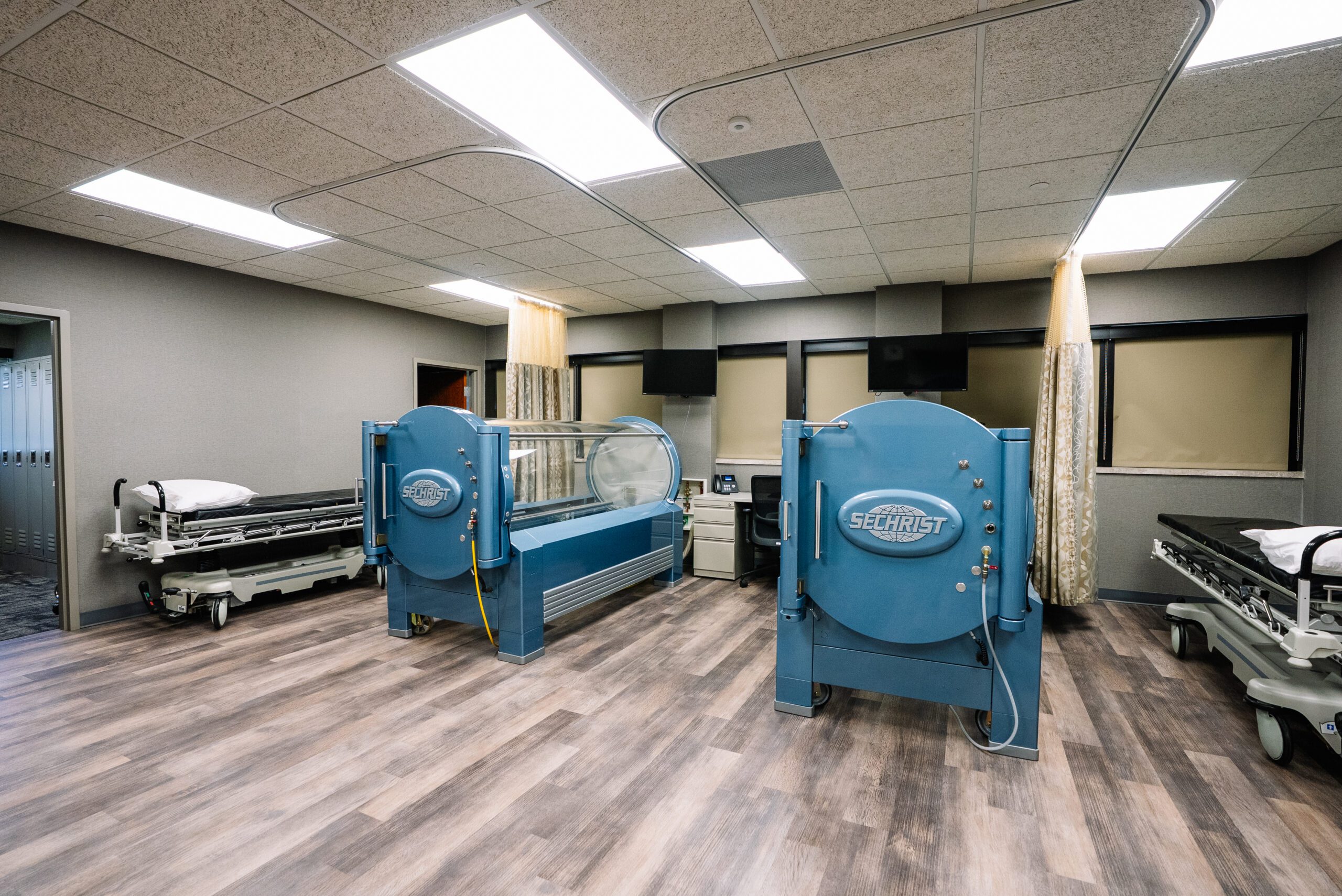May is hyperbaric awareness month, and the team at Innovative Wound Care in Flint, Michigan, wants to provide insight and knowledge on this life-changing treatment. This is an initiative led by the Undersea & Hyperbaric Medical Society to educate the public on the benefits of hyperbaric oxygen therapy, or HBOT.
HBOT is ideal for wound healing and treatment, but let’s take a closer look at how it works, its benefits, what it can treat, and more.
What is Hyperbaric Oxygen Therapy?
Hyperbaric oxygen therapy, or HBOT, is a form of wound therapy where a patient enters a pressurized chamber and breathes in 100% oxygen, which increases the amount of oxygen delivered to the body’s tissues. This type of therapy usually lasts one to two hours per session.
What Can HBOT Treat?
Many wound specialists look to HBOT to treat a variety of conditions, such as:
- Diabetic Ulcers: Diabetic ulcers are slow, non-healing open wounds common in diabetic patients and are caused by nerve damage, poor circulation, improper footwear, and high blood sugar.
- Burns: Second-degree and third-degree burns can cause serious damage to the skin, severe swelling, redness, and destroy the top layers of skin, all leading to additional complications.
- Pressure Injuries: Pressure injuries can develop on the skin from constant pressure or friction, leading to a lack of blood flow and tissue damage – these injuries are also known as bedsores.
- Lower Extremity Edema: Lower extremity edema develops from too much fluid buildup in the lower extremities, causing excessive swelling.
For a complete list of conditions HBOT can treat, visit the UHMS resource page.
How Does HBOT Work?
HBOT treats conditions like ulcers, burns, pressure injuries, and lower extremity edema in 2 key ways – oxygen concentration and delivery.
When a patient enters an HBOT chamber, the chamber is pressurized, exposing patients to 100% oxygen. Due to the chamber’s pressurization, the oxygen can dissolve more easily into the body’s plasma. What makes this enhancement of oxygen to the body is its delivery, since oxygen is traditionally carried to tissues by red blood cells.
Ultimately, HBOT works by allowing the body to absorb oxygen more directly into the patient’s blood and tissues, helping to provide optimal healing to non-healing wounds or injuries.
What Does a HBOT Session Look Like?
If you are experiencing one of the listed conditions above, and your doctor deems it necessary to undergo an HBOT session, here is what you can expect:
Before HBOT Appointment
Your provider will encourage you to arrive at your HBOT appointment in 100% cotton clothing to avoid static electricity while in the chamber. If this is not possible, your medical provider can provide you with a hospital gown instead. You will also want to avoid wearing jewelry and remove all piercings before your appointment. In addition, you will want to avoid using perfume, body lotion, deodorant, makeup, and even hair products before your appointment, as these chemicals may interact with the chamber’s mechanics.
Be sure to share any medications you are taking with your doctor, as you may need to pause them in the days leading up to your appointment.
Regarding food before your HBOT appointment, try to stick to a light meal at least 1 – 2 hours before entering the chamber. Similarly, avoid smoking, alcohol, caffeine, and carbonated beverages before your session, as these types of drinks can also impact the effectiveness of this type of therapy.
During the HBOT Appointment
When it is time to begin your HBOT session, you will lie on a bed that slides into the chamber, which is then sealed and pressurized with 100% oxygen. When the pressure begins to slowly increase, it will be normal to feel a popping sound in your ear, like the same sensation that can occur when flying in a plane. An HBOT session can last anywhere from 60 – 90 minutes, and to pass the time, patients can watch TV, listen to music, or rest! A technician will monitor your entire session.
After HBOT Appointment
After 60 – 90 minutes in the chamber, the chamber is then depressurized. You may feel tired or lightheaded, which is completely normal. Your medical provider will check your ears and vitals and send you on your way!
There is minimal downtime following an HBOT session, but it is suggested that you rest and stay hydrated!
Risks and Side Effects from HBOT Treatment
With any type of treatment, there are side effects and risks patients should be aware of. Most side effects that come from an HBOT treatment are completely normal and usually subside within a day or two. Here are some common side effects of an HBOT session:
- Fatigue
- Lightheadedness
- Fullness or popping of ear(s)
- Vision changes
- More serious risks and side effects associated with HBOT treatment to consider include:
- Oxygen toxicity
- Seizures
- Lung damage
- Decompression sickness
Discussing with your doctor your medical history will be helpful in determining if HBOT is right for you, while also considering the potential risks and side effects associated with this treatment.
Is HBOT Safe?
When administered by trained professionals, HBOT is a safe and well-tolerated therapy. Treatments are conducted under medical supervision, and patients typically report a relaxing, pressure-adjusted experience.
How Many HBOT Sessions Are Needed for Results?
The number of HBOT sessions a patient needs to undergo to see results will depend on the type and severity of the condition being treated. On average, patients typically undergo 10 – 20 HBOT sessions to see improvement in conditions and for further healing.
Will I Feel Claustrophobic in an HBOT Chamber?
This is a common hesitation for patients when given the option to undergo HBOT therapy, as they fear it may cause their claustrophobia to flare up. While this is a real thing for many patients, patients should know that it is not too common. Since the chamber is rather large, with clear viewing windows, that allows patients to feel more comfortable by seeing their surroundings and light.
In addition, all HBOT sessions are monitored by skilled medical professionals in case of emergency. If patients are anxious to undergo this treatment, then a medical provider may be able to provide the proper medication for patients to feel relaxed and calm during their session.
Why Awareness Matters
Many patients don’t discover a treatment like HBOT until their condition has worsened, even though earlier intervention could have brought a faster recovery and fewer complications. This is why hyperbaric awareness month is vital, and at Innovative Wound Care, our goal is to keep our community in the know about this life-saving treatment—and to encourage proactive care.
Hyperbaric Oxygen Therapy at Innovative Wound Care in Flint, Michigan
If you or a loved one is facing a chronic wound or complex medical condition, HBOT might be the right option for your path to healing. Allow the team at Innovative Wound Care in Flint, Michigan to be a part of your healing journey.
We offer hyperbaric oxygen therapy among additional therapy options for chronic wounds and injuries. Contact us today to learn more – don’t suffer in pain a day longer.
We look forward to hearing from you.




Leave A Comment